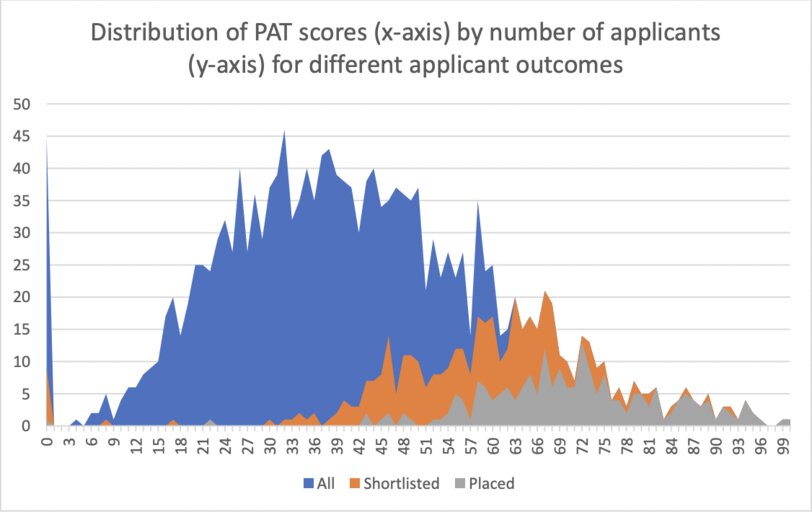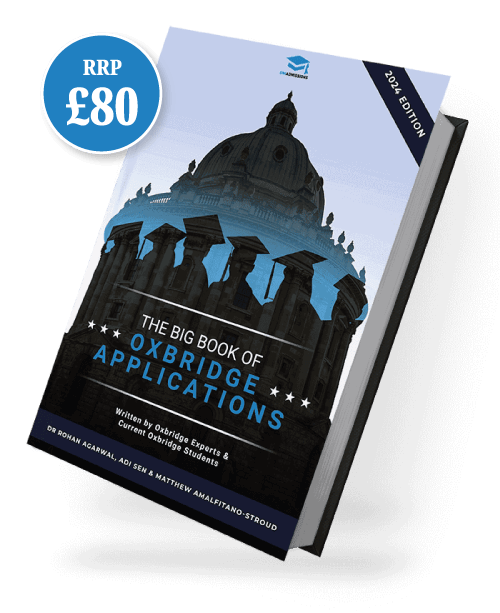Please be aware that the PAT is currently undergoing a format change. The PAT will now be computer-based and there will only be Multiple-Choice Questions in the test. Some of the information in this guide is out of date and will be fully updated once full information about the new PAT scoring system is released.
When applying to Oxford to study a Physics-based subject, the PAT is an important step of the application process.
Like any other Admissions Test, the PAT is one part of your university application so doing well in it is important. So understanding how the PAT is scored and your results presented to you will be one less weight to bear.
Which is why we have put together this guide going over everything you need to know about the scoring and results of the PAT.
How is the PAT Scored?
The PAT has always been scored out of 100 marks, with your final score being converted into a percentage. However, how those points are distributed has changed due to the format update which removed all written questions in favour of multiple-choice questions.
With 100 marks available, the PAT will feature 40 questions overall. Within the test, each question is worth either 2 or 3 marks based on the difficulty of the question. This is based on the practice test that Oxford has released for the PAT, although one 4-mark question was also present in the test.
Beyond this, there isn’t much else to learn about this marking scheme as it’s incredibly simple due to the nature of the test. There is no negative marking in the PAT, therefore you will will not lose any of the marks you have accumulated.
Searching for PAT support to boost your score?
The PAT is a vital component of your Oxford application so scoring highly can mean the difference between an offer or rejection.
Discover our PAT Programme by clicking the button below to enrol and triple your chances of success.
When do you get your PAT results?
Firstly, you will likely be wondering when do you actually get your results.
For students who sit the PAT on the 18th October 2024; PAT scores will be distributed to all applicants for Materials Science and Engineering, and to all unsuccessful applicants for Physics and Physics and Philosophy, shortly after college decision letters are sent in January.
The Oxford college you are applying to will already have your results so there is nothing you need to do.
past PAT Scores
Unlike the vast majority of the Admissions Test, previous PAT marks are presented in a way that contextualises the results more.
The Admissions Report document shares information such as how many people sat the paper, and compared statistics with that of previous years.
This is a helpful way to know where you stand when doing past papers to grasp a better understanding of whether you actually done well or not. However, be aware that these scores won’t be as accurate when looking at the 2024 PAT as the exam has a different format.
If you are interested in taking a closer look at the examiners’ reports, you can find them here.
Other than that, Oxford does not provide much information but from trends in the reports we can see a threshold mark, below which candidates will not be placed on the interview short-list. This mark will not be determined until the results of the tests are available.
The mean score on the PAT in 2020 was 49 with the highest score of 97 and a minimum of 8. Candidates seeking to gain an interview will be looking to score in the 60+ region. Obviously, the higher the better.
With this in mind, we can take a look at the 2021 PAT results.
PAT 2021 Results
Below you can see the score distributions for the 2021 PAT.
One thing it is particularly interesting is that it notes which applicants were shortlisted and those that were ultimately placed – note candidates receive this information after receiving their decision.
There is a spike at 0, which Oxford has clarified represents those who did not register for the PAT test, applicants who had Covid or other special circumstances on the date of the PAT test, and applicants who have to do compulsory military service for whom acceptance is carried over from a previous admissions round.
It has been noted that the 2021 PAT was harder than the previous years with a mean mark of 43.1% – it was 49.5% in 2020.
Oxford has citied the lower scores due to disruptions caused by the pandemic, and as a result set a higher automatic threshold than in previous years. This was set at 63% (confirming what was stated above, with 60+ being where you should be aiming for).

PAT Format Change
How does the PAT format change affect this information? In short, the PAT is likely to be easier now that all the longer questions have been replaced with multiple-choice questions. While the content will still be difficult, the format of multiple-choice is generally much easier as it requires less working out and can be guessed if needed.
If the test is easier, the score distribution is likely to go up, meaning you’ll have to score higher to be within the top 10% of applicants and have a healthy chance of getting an interview. Therefore, it’s vital that you still thoroughly prepare for the test to ensure you can get as high a score as possible.
Access "The Big Book Of Oxbridge Applications" For FREE
If you’re applying for Physics or Engineering at Oxford, then you’ll need to be prepared for not just the PAT but the other parts of the application process too. You can learn about everything you need to know about Oxbridge applications in The Big Book Of Oxbridge Applications, available for free here! Through over 350 pages, you will find:
- Over 40 admissions test practice questions
- 28 example Oxbridge Personal Statements
- Interviews with Oxbridge students and graduates
- Additional downloadable resources
Fill in your details below to claim your digital copy today!

what are good, average, and low PAT scores?
The distribution tables above provide an idea of what scores candidates have achieved, with a brief explanation of the tables themselves. But what actually is a good, average, or low score?
Based on what we have seen for the previous year’s results and the information provided by Oxford, we can see a pattern in regard to the scores. These can be categorised as follows:
What is a Good PAT Score?
It is generally agreed that anything from 70 and above is considered a good PAT score. A score of 80+ would be even better, but only the most exceptional applicant will achieve this. As you can see in the distribution charts above, around this mark is where there is a drop-off in the results, but remember that this is based on the old PAT format which was more difficult.
What is an Average PAT Score?
For the average PAT score, you would be looking at anything between 50 and 60.; the vast majority of applicants will find themselves in this category. The table above clearly demonstrates that applicants in this range will be shortlisted.
What is a Low PAT Score?
Anything below a 50, therefore, is considered a low PAT score. From the table above, we can that very few applicants find them shortlisted with a score of 40 or below, and subsequently very rarely placed.
Conclusion
Hopefully, from the above, you have a better understanding of how the scoring and results of the PAT works.
What is key to remember is that the conversion table and the distribution of results are not set in stone and will fluctuate each year due to the perceived difficulty of the Admissions Test.
The PAT is difficult, and it is designed to be that way, so do not feel disheartened if you feel you did not do your best as chances are everyone will have felt that way.
Maximise your PAT score through effective PAT preparation.
The PAT is a vital component of your Oxford application so scoring highly can mean the difference between an offer or rejection. At UniAdmissions, we are experts at boosting your PAT score and maximising your chances of gaining a place.
Discover our PAT Programme by clicking the button below to enrol and triple your chances of success.







